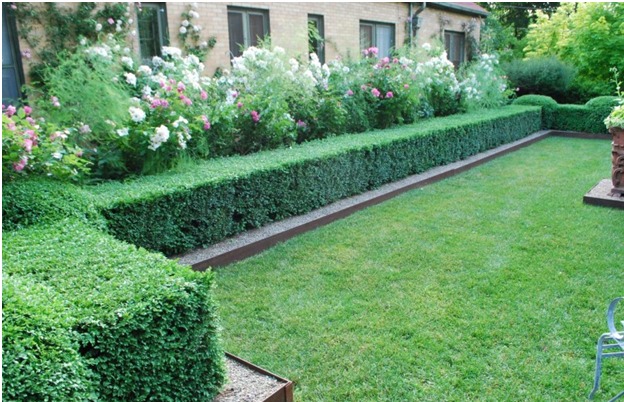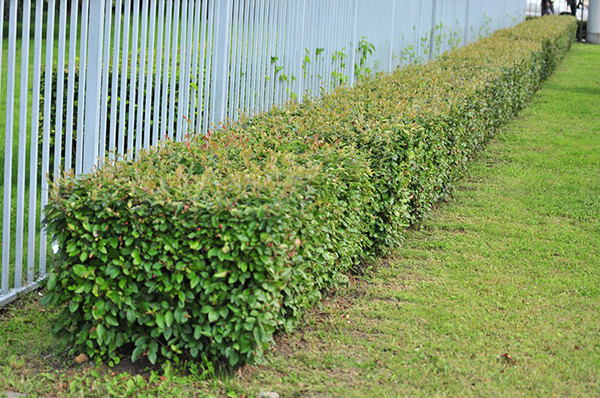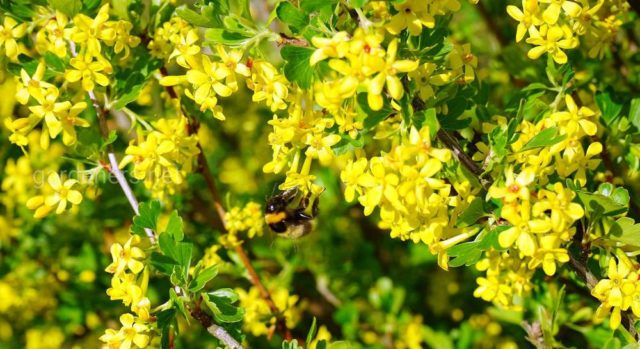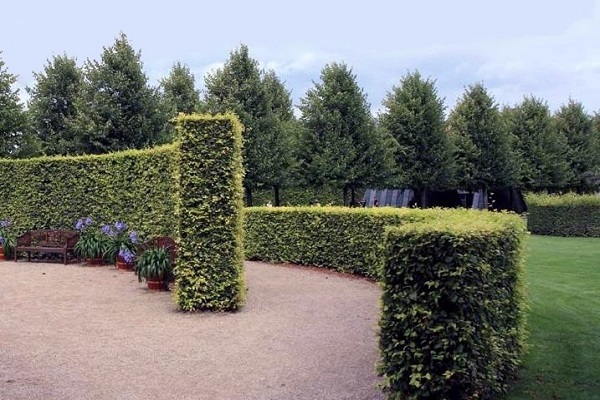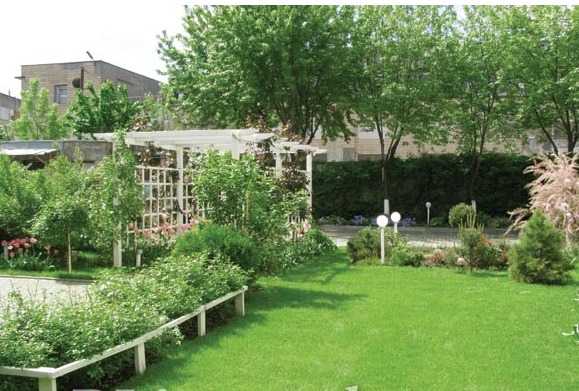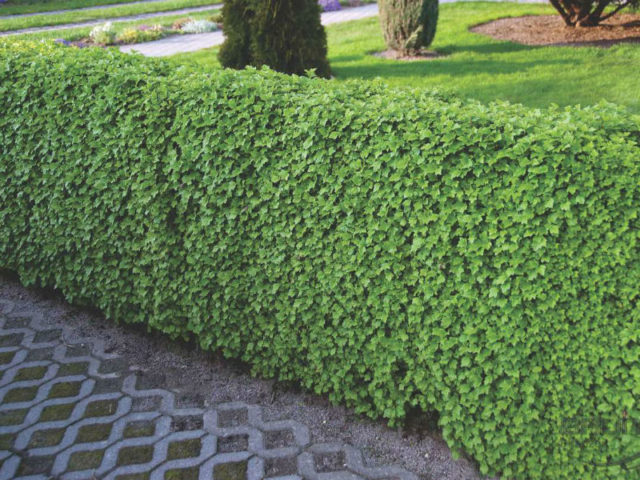Content
Despite the fact that modern landscape designers are increasingly trying to move away from the Soviet-style garden, various berry bushes do not lose their popularity when decorating the space of the site. One of them is black currant. In the light of new trends in garden design, a black currant hedge will be an interesting solution.
Currant bushes in landscape design
Landscape designers love to use berry bushes to decorate the landscape, as they are very good for highlighting or zoning a space. In addition, due to the different heights of individual species, it is possible to assemble a separate composition, which will represent a “tasty” corner of the garden. Currant is mainly used in three cases:
- As the center of a flower arrangement, around which a flower bed is planted. Here the currant acts as an accent that gives the design more organization.
- As a separator between plantings. Through this use, other plants will stay within their boundaries. This technique goes into effect when black currants are planted at the base of the alpine hills.
- As a fence for zoning. Black currant bushes can be of any height up to three meters, so with proper care they make excellent hedges. Thanks to them, you can divide the space, hide the fence or metal rungs.
Features of currant hedge
Most often, currants are still used to create a hedge around a part of the site, replacing or supplementing the fence with it. The shrub is great for these purposes for several reasons:
- The plant calmly takes root in the Russian climate and after it has finally taken root, it is not afraid of drought or excessive moisture;
- Currant bushes grow widely, due to which they create a dense green wall if they are planted next to each other;
- The shrub does not have thorns, but it has beautiful wide leaves that turn yellow with the onset of autumn;
- The plant blooms with small flowers, pleasant to the eye, reminiscent of bells;
- There are several types of black currant, and they all differ in height, so it will be quite easy to choose the one that is needed in a particular situation.
Despite the fact that currants are relatively unpretentious, when planting, they need to create comfortable conditions for the plant to take root. For this purpose, it is necessary to cultivate the soil in which it is planned to plant the shrub. To do this, add a pound of tree bark and 200 g of humus to the hole under the currants, so that it is easier for the shrub to take root. In addition, in the first three to four years, the bushes must be fertilized and watered in the summer so that they begin to bear fruit.
Currant varieties for hedges
In total, there are 14 varieties of currants, but most of them are not suitable for landscape design. Only two types of crops are in particular demand: black and golden currants. They are both very beautiful and perfectly suited for a fence, but they still have a few important differences.
Black currant bushes can be of any height, therefore they are suitable for both external and internal zoning of the site. More often they are still used in the second case, since a rarer green hedge is obtained from them.The plant bears fruit with black, brown or dark purple berries in late summer and blooms with small white bells. The berries can be used to make jams, jams, sauces, or eaten unprocessed. In autumn, you should not expect a lot of colorful leaves from black currant - the shrub remains green for a long time, then somewhere closer to October it quickly turns yellow and loses its foliage. The culture usually reaches a height of no more than 1.5 meters.
Photo of black currant hedge:
Golden currants have a more decorative purpose than black ones. Berries also grow on it, but in taste they are much inferior to the previous described variety. But it blooms with bright yellow flowers that completely cover the entire bush, and in the fall, golden currants can please with colorful colorful leaves.
In addition, its bushes grow up to three meters in height, making it suitable for hedges along the fence.
How to plant currant hedges?
Planting black and golden currants should not cause any problems: the process is quite simple and does not require large physical or time costs. In total, it consists of 5 stages:
- Mark the area where the bushes will be planted. To create a hedge, plants should be placed in a straight line at a distance of half a meter to a meter from each other.
- Next, you need to dig up the soil and dig holes for the seedlings, which should be half a meter in width and depth.
- Then, fertilizer, bark and a little humus must be added to each groove to make it easier for the plants to take root.
- The seedling can now be planted. Depending on the variety, it is important to dig in from a third to half of the seedling, so it will be easier for it to root. Before planting, pour half a bucket of water into the recess.
- After the plants are planted, it is important again to water them and sprinkle them with black earth.
How to care for a currant hedge
Blackcurrant hedges do not require careful maintenance, but it is very important to prune them in time to keep their shape. This treatment should be started when the shrubs reach 40-60 cm in height. If you miss this moment and do not have time to give them shape when they are still small, then it will be quite difficult to cope with the grown plants in the hedge. Black currant grows quickly, so its branches will creep in all directions and spoil the original design. If you give it a shape early, then these problems can be avoided, since in this case you will not have to completely redo the silhouette of the bush, but only cut off the excess branches.
In addition, for the first two to three years, it is very important to fertilize the plants and water them during the fruiting period, so that they quickly grow and form a hedge.
Landscape tricks with currants in the garden
As mentioned earlier, black and golden currants can be added to the landscape as an accent or as a restriction for other vegetation, but these crops can also act as a separate decorative element. There are several ways to do this:
- You can compose a composition of bushes of different heights to get a kind of level gardening. This technique can be used on hilly or uneven terrain to visually level the terrain. In addition, such a composition can be planted along an alpine slide in order to create a parallel to it, but then the shrubs will act not as a separate element of the garden, but as an accent;
- You can create a small berry garden, separate from the main one, which could act as a zone of peace and quiet. Black currant bushes provide excellent shade, and they do not attract so many insects, so nothing can interfere with a quiet pastime in this corner;
- You can plant currants along the paths, and then during flowering and fruiting, it will decorate the garden no worse than individual pots of flowers.
A variant of a black currant hedge along the paths in the photo:
Conclusion
The black currant hedge is a great opportunity to create a unique landscape. This species, along with golden currants, despite the fact that it is not strictly an ornamental plant, can perform several landscape functions, including space zoning. In addition, she adds "flavor" to the garden, because her berries are the same symbol of summer as strawberries or watermelons. In any case, the presence of culture on the site will definitely decorate the landscape, and the ease of caring for it will significantly save time and effort for gardeners.
